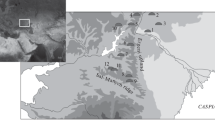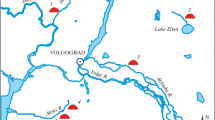Abstract
The article discusses the time frame and the role of the anthropogenic factor in the solonetz process in soils of the desert–steppe zone of the southeastern Russian Plain. Based on the study of soils of different ages buried under the mounds of the Bronze and Middle Ages (6200–700 years ago) within the Salsko–Manych ridge, it was established that the soils of the region did not bear signs of the solonetz process at the macro level before the beginning of the 3rd millennium BC. The first solonetzes in the region began to form 4800–4700 years ago. Their appearance chronologically coincided with the beginning of increased climate aridization. During this period, desert steppes began to be actively inhabited by ancient cattle breeders specializing in breeding small cattle, which resulted in a sharp increase in the load on the soils and ecosystems of the steppe. The article considers the possible cause-effect relationships in the system “climate–economic model–solonetz process.”



Similar content being viewed by others
Notes
Hereinafter: the interval of calibrated radiocarbon dates in the years BC is indicated; in parentheses is the radiocarbon laboratory index and date number.
REFERENCES
Aleksandrovskii, A.L. and Aleksandrovskaya, E.I., Evolyutsiya pochv i geograficheskaya sreda (Soil Evolution and Geographic Environment), Moscow: Nauka, 2005.
Alekseeva, T., Alekseev, A., Maher, B.A. and Demkin, V., Late Holocene climate reconstructions for the Russian steppe, based on mineralogical and magnetic properties of buried palaeosols, Palaeogeogr., Palaeoclimatol., Palaeoecol., 2007, vol. 249, pp. 103–127.
Alekseeva, T.V., Alekseev, A.O., Demkin, V.A., Alekseeva, V.A., Sokolowska, Z., Hajnos, M., and Kalinin, P.I., Physicochemical and mineralogical diagnostic features of solonetzic process in soils of the Lower Volga region in the late Holocene, Eurasian Soil Sci., 2010, vol. 43, no. 10, pp. 1083–1101.
Antipov-Karataev, I.N., Origin and geographic distribution of solonchaks in USSR, in Melioratsiya solontsov v SSSR (Melioration of Solonchaks in USSR), Moscow, 1953, pp. 9–266.
Arinushkina, E.V., Rukovodstvo po khimicheskomu analizu pochv (Manual for Chemical Analysis of Soils), Moscow: Mosk. Gos. Univ., 1970.
Aston, M., Interpreting the Landscape: Landscape Archaeology and Local History, London: Routledge, 1985.
Bintliff, J., The concepts of ‘site’ and ‘offsite’ archaeology in surface artifact survey, in Non-Destructive Techniques Applied to Landscape Archaeology, Pasquinucci, M. and Trément, F., Eds., Oxford: Oxbow Books. 2000, pp. 200–215.
Bobrovsky, M.V., Kupriaynov, D.A., and Khanina, L.G., Anthropological and morphological analysis of soils for the reconstruction of the forest ecosystem history (Meshchera lowlands, Russia), Quat. Int., 2018, vol. 516, pp. 70–82.
Borisov, A.V., El’tsov, M.V., Shishlina, N.I., Demkina, T.S., and Demkin, V.A., Paleosol studies of kurgans of the Catacomb culture (second half of the third millennium BC) in Kalmykia, Eurasian Soil Sci., 2005, vol. 38, no. 2, pp. 123–131.
Borisov, A.V., Mimokhod, R.A., and Demkin, V.A., Paleosols and nature conditions of southern Russian steppes in Catacomb period, Kratk. Soobshch. Inst. Arkheol., 2011, no. 225, pp. 144–154.
Chizhikova, N.P., Kovda, I.V., Borisov, A.V., and Shishlina, N.I., The solonetzic process in surface soils and buried paleosols and its reflection in the mineralogical soil memory, Eurasian Soil Sci., 2009, vol. 42, no. 10, pp. 1179–1189.
David, B. and Thomas, J., Landscape archaeology: introduction, in Handbook of Landscape Archaeology, David, B. and Thomas J., Eds., Walnut Creek: Left Coast Press, 2008, pp. 27–43.
Demkin, V.A., Pochvovedenie i arkheologiya (Soil Science and Archeology), Pushchino: Nauchn. Tsentr Biol. Issled., Akad. Nauk SSSR, 1997.
Demkin, V.A. and Lukashov, A.V., Velocity and properties of pedogenic processes in the area of dry steppes in Holocene, Pochvovedenie, 1987, no. 6, pp. 5–14.
Gedroits, K.K., Izbrannye sochineniya. Tom 1. Pochvennye kolloidy i poglotitel’naya sposobnost’ pochv (Selected Research Works, Vol. 1: Soil Colloids and Absroption Ability of Soils), Moscow: Sel’khozgiz, 1955.
Gennadiev, A.N. and Puzanova, T.A., Evolution of soils and nature-ecological conditions in lowland part of Kalmykia in Holocene, in Problemy drevnei isotrii Severnogo Prikaspiya (Problems of Ancient History of Northern Caspian Region), Kuibyshev, 1990, pp. 71–72.
Gol’eva, A.A., Microbiomorphic soil memory, in Pamyat’ pochv: Pochva kak pamyat’ biosferno-geosferno-antroposfernykh vzaimodeistvii (Soil Memory: Soil as a Memory of the Biosphere–Geosphere–Anthroposphere Interactions), Targul’yan, V.O. and Goryachkin, S.V., Ed., Moscow: LKI, 2008, pp. 499–529.
Ivanov, I.V., Evolyutsiya pochv stepnoi zony v golotsene (Evolution of Soils of Steppe Zone in Holocene), Moscow: Nauka, 1992.
Ivanov, V.V., Stepi Zapadnogo Kazakhstana v svyazi s dinamikoi ikh pokrova (Steppes of Western Caucasus Related with Dynamics of Their Cover), Moscow: Akad. Nauk SSSR, 1958.
Ivanova, E.N., Slonchaks of chestnut soil zone of Volga-Ural interfluve, in Pochvy kompleksnoi ravniny Severnogo Prikaspiya i ikh meliorativnaya kharakteristika (Soils of the Complex Plain of Northern Caspian Region and Their Meliorative Characteristic), Moscow: Nauka, 1964, pp. 114–155.
Ivanova, E.N. and Fridland, V.M., Soil complexes of dry steppes and their evolution, in Voprosy uluchsheniya kormovoi bazy v stepnoi, polupustynnoi i pustynnoi zonakh SSSR (Improvement of Fodder Resources in Steppe, Semidesert, and Desert Zones of USSR), Moscow: Akad. Nauk SSSR, 1954, pp. 162–190.
Khitrov, N.B., Genezis, diagnostika, svoistva i funktsionirovanie glinistykh nabukhayushchikh pochv Tsentral’nogo Predkavkaz’ya (Genesis, Diagnostics, Properties, and Functions of Clay Swallowing Soils of Central Cis-Caucasus Region), Moscow: Rossleskhozakademiya, 2003.
Khitrov, N.B., The choice of diagnostic criteria to judge the development of the solonetzic process in soils, Eurasian Soil Sci., 2004, vol. 37, no. 1, pp. 12–23.
Khitrov, N.B., The relationship between the soils of solonetzic complexes in the northern Caspian Lowland and the local microtopography, Eurasian Soil Sci., 2005, vol. 38, no. 3, pp. 237–249.
Kovda, V.A., Solonchaki i solontsy (Solonchaks and Solonetzes), Moscow: Akad. Nauk SSSR, 1937.
Kravtsova, L.P., Nikitina, M.M., Dmitrieva, M.A., and Kuznetsova, T.I., Evaluation of seasonal productivity and volume of steppe pastures for annual cattle grazing, Dostizh. Nauki Tekhn. APK, 2011, no. 4, pp. 48–50.
Lisetskii, F.N., Stolba, V.F., and Pichura, V.I., Late-Holocene paleoenvironments of Southern Crimea; soils, soil-climate relationship and human impact, Holocene, 2017, vol. 27, no. 12, pp. 1859–1875.
Magomedov, M.-R.D. and Murtazaliev, R.A., The impact of grazing on the productivity and structure of vegetation of pasture ecosystems of the Terek-Kuma Lowland, Arid.Ekosist., 2001, vol. 7, nos. 14–15, pp. 39–53.
Masanov, N.E., Kochevaya tsivilizatsiya kazakhov: osnovy zhiznedeyatel’nosti nomandskogo obshchestva (The Nomadic Civilization of the Kazakhs: The Principles of Nomadic Society), Moscow: Gorizont, 1995.
Mimokhod, R.A., Lolinskaya culture. The middle and late periods of the Bronze Age in Northwest Caspian region, in Materialy okhrannykh arkheologicheskikh issledovanii (Materials of Protective Archeological Studies), Moscow: Inst. Arkheol., Ross. Akad. Nauk, 2013, vol. 16.
Novenko, E.Y., Mazei, N.G., Kupriyanov, D.A., Nizovtsev, V.A., Tsyganov, A.N., Rudenko, O.V., Bobrovsky, M.V., and Erman, N.M., Paleoecological evidence for climatic and human impact on vegetation in the temperate deciduous forest zone of European Russia during the last 4200 years: a case study from the Kaluzhskiye Zaseki natural reserve, Quat. Int., 2018, vol. 516, p. 58.
Rode, A.A., Water regime and balance of virgin soils of semidesert complex, in Vodnyi rehzim pochv polupustyni (Water Regime of Semidesert Soils), Moscow: Nauka, 1968, pp. 88–142.
Rode, A.A. and Pol’skii, M.N., Soils of Dzhanybek Stationer, Tr. Pochv. Inst.im.V.V. Dokuchaeva, 1961, vol. 56, pp. 3–214.
Sen’kov, A.A., Galogenez stepnykh pochv (Halogenesis of Steppe Soils), Novosibirsk: Sib. Otd., Ross. Akad. Nauk, 2004.
Shishlina, N.I., Severozapadnyi Prikaspii v epokhu bronzy (V–III tys. do n.e.) (Northwestern Capian Region in Bronze Age, 5th–3rd BC), Moscow, 2007.
Shishlina, N.I. and Bulatov, V.E., Seasonal system of pasture use in Yamnaya culture in Caspian steppes in 3rd century BC, in Sezonnyi ekonomicheskii tsikl naseleniya Severo-zapadnogo Prikaspiya v bronzovom veke (Seasonal Economic Cycle of Population of Northwestern Caspian Region in Bronze Age), Tr. Gos. Istor. Muz., Moscow: Gos. Istor. Muz., 2000, no. 120, pp. 43–53.
Slavnyi Yu.A., On the theory of automorphic solonetzes formation, Eurasian Soil Sci., 2001, vol. 34, no. 5, pp. 455–459.
Trifonov, V.A., Corrections to absolute chronology of cultures of Eneolith–Middle Bronze Age of Caucasus, steppe and forest-steppe zones of Eastern Europe, Materialy mezhdunarodnoi nauchnoi konferentsii “K stoletiyu periodizatsii V.A. Gorodtsova bronzovogo veka yuzhnoi poloviny Vostochnoi Evropy” (Proc. Int. Sci. Conf. “To the 100-Year of Periodization of Bronze Age in Southern Part of Eastern Europe by V.A. Gorodtsov”), Samara: Nauchno-Tekh. Tsentr, 2001, pp. 71–82.
Zalibekov, Z.G., Biological concept of desertification, Arid.Ekosist., 1997, vol. 3, no. 5, pp. 7–16.
Funding
The work was carried out as part of the State Assignment no. 0191-2019-0046 “Soil Development in a Changing Climate and Anthropogenic Impacts”. Chemical analyzes were carried out at the expense of the RSF grant no. 17-18-01406 “Environmental determinism of the development of ancient societies: economic models of the population of the Bronze Age of the Caucasus and the steppe in a changing climate.”
Author information
Authors and Affiliations
Corresponding author
Ethics declarations
Conflict of interests. The authors declare that they have no conflicts of interest.
Statement on the welfare of animals. This article does not contain any studies involving animals performed by any of the authors.
Rights and permissions
About this article
Cite this article
Borisov, A.V., Alekseev, A.O. Timing and Causes of the Origin of the Solonetz Process in the Desert–Steppe Soils of the Southeastern Russian Plain. Arid Ecosyst 10, 27–35 (2020). https://doi.org/10.1134/S2079096120010023
Received:
Revised:
Accepted:
Published:
Issue Date:
DOI: https://doi.org/10.1134/S2079096120010023




